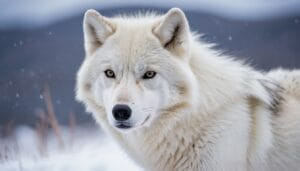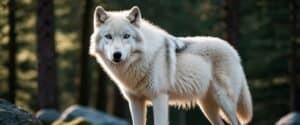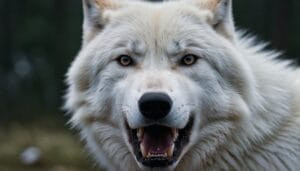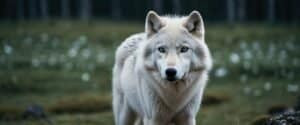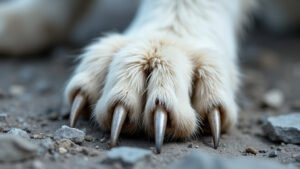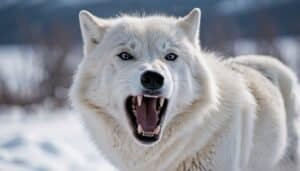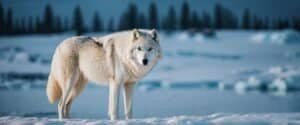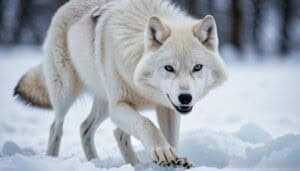Introduction
The Arctic wolf, adapted to the frigid conditions of its environment, possesses a unique fur structure that plays a crucial role in its survival
This article explores the differences between the Arctic wolf’s outer coat and undercoat, examining their characteristics, functions, and seasonal changes. We will also delve into the evolutionary advantages provided by these fur layers and how environmental factors, including climate change, impact the Arctic wolf’s fur
Differences Between Arctic Wolf’s Outer Coat and Undercoat
The Arctic wolf’s fur is a remarkable adaptation that allows it to thrive in one of the harshest environments on Earth. Understanding the distinctions between its outer coat and undercoat reveals the complexity and efficiency of these adaptations
Characteristics and Functions of the Outer Coat
The outer coat of the Arctic wolf, also known as the guard hair layer, consists of long, coarse hairs that provide a protective barrier against the elements. These hairs can be up to 5 inches (12.7 cm) long, significantly longer than those of the undercoat
The primary functions of the outer coat include:
Protection Against Moisture: The coarse hairs of the outer coat are water-resistant, which helps to keep the undercoat dry and insulates the wolf from the snow and ice it encounters in its habitat
Shield from Wind: The outer coat acts as a windbreaker, reducing the impact of cold Arctic winds that can drastically lower body temperatures
Camouflage: The color and texture of the outer coat help the Arctic wolf blend into its snowy surroundings, aiding in hunting and evasion from predators. The coat’s color varies from white to creamy, offering excellent camouflage in winter landscapes
The outer coat is not just functional but also aesthetically important. It gives the Arctic wolf its majestic and imposing appearance, which can be crucial during interactions with other wolves and predators
Characteristics and Functions of the Undercoat
Beneath the outer coat lies the undercoat, a dense layer of short, soft, and fine hairs. This layer is crucial for insulation and maintaining body temperature
Key characteristics and functions of the undercoat include:
Thermal Insulation: The undercoat traps air close to the wolf’s body, providing excellent insulation. This trapped air acts as a thermal barrier, retaining body heat and preventing cold from penetrating
Soft and Dense Fur: Unlike the coarse outer coat, the undercoat consists of soft and fluffy hairs that create a dense barrier against the cold. This layer is much finer and shorter, typically around 1-2 inches (2.5-5 cm) long
Seasonal Shedding: The undercoat undergoes significant changes with the seasons. During the spring and summer, the Arctic wolf sheds much of its undercoat to prevent overheating, while in the fall, a new, denser layer grows to prepare for the upcoming winter
The undercoat is vital for the Arctic wolf’s survival in extremely low temperatures, sometimes dropping to -70°F (-57°C). Without this insulating layer, maintaining a stable core body temperature would be nearly impossible
Seasonal and Environmental Changes in Arctic Wolf Fur
The fur of the Arctic wolf undergoes significant transformations throughout the year to adapt to the extreme seasonal changes in the Arctic. These adaptations ensure the wolf’s survival in both the freezing winters and the relatively milder summers
Winter Adaptations and Summer Shedding
The Arctic wolf’s fur is an excellent example of how animals have evolved to thrive in harsh climates. During the winter, the fur undergoes several changes to provide maximum protection against the cold
Winter Adaptations
Increased Density: As winter approaches, the Arctic wolf grows a denser undercoat. This thick layer of fine, insulating hairs provides critical thermal insulation
Studies have shown that this adaptation helps Arctic wolves maintain a body temperature of about 104°F (40°C), even when the outside temperature plummets to -70°F (-57°C)
Longer Guard Hairs: The outer coat also becomes longer and thicker in winter. The guard hairs grow up to 5 inches (12.7 cm) long, creating an effective barrier against wind and snow
Color Changes: The fur often turns whiter during the winter months, providing better camouflage in the snow-covered landscape. This change helps wolves avoid detection by both prey and predators
Summer Shedding
Loss of Undercoat: In spring and summer, the Arctic wolf sheds much of its undercoat to prevent overheating. This process involves the gradual loss of the dense, insulating hairs, which are replaced by a thinner layer
Shorter Guard Hairs: The outer coat also becomes shorter and less dense, reducing the insulating effect and allowing for better temperature regulation during the warmer months. This shedding process is crucial for the wolf’s comfort and health in temperatures that can rise to 50°F (10°C) or higher in the Arctic summer
Color Changes: The fur color may darken slightly in summer, offering some protection against the stronger sunlight and helping to blend in with the more varied summer terrain
The cyclical nature of these fur changes is vital for the Arctic wolf’s ability to survive and thrive in an environment with such extreme seasonal variations
Climate Change Effects and Adaptations
Climate change poses new challenges for the Arctic wolf, as shifting temperatures and weather patterns can disrupt the delicate balance of their fur adaptations
Impact of Warmer Winters
Delayed Fur Growth: Warmer winters can lead to a delayed growth of the insulating undercoat. This can make Arctic wolves more vulnerable to sudden cold snaps and other unpredictable weather changes
Reduced Fur Density: Prolonged periods of warmer weather may result in a thinner undercoat, reducing the overall insulation and making it harder for the wolves to maintain their body temperature during unexpected cold periods
Impact of Hotter Summers
Increased Shedding: Hotter summers can cause Arctic wolves to shed their fur more extensively and earlier in the season, which may leave them underprepared for early winter conditions
Heat Stress: With climate change causing more frequent heatwaves, Arctic wolves might experience increased heat stress, as their thick fur is not designed for prolonged exposure to high temperatures. This can lead to behavioral changes, such as seeking shade or water sources more frequently
Adaptations to Environmental Stressors
Behavioral Changes: In response to changing conditions, Arctic wolves may alter their behaviors, such as hunting patterns and denning habits, to adapt to new environmental pressures. For instance, they might hunt more at night to avoid the heat of the day during warmer periods
Genetic Adaptations: Over time, genetic adaptations might occur, leading to changes in the fur’s characteristics. These adaptations could include variations in fur density, length, and shedding patterns to better suit the new climate realities
Research continues to explore how Arctic wolves are adjusting to these environmental changes. Conservation efforts are also critical in monitoring and supporting these adaptations to ensure the survival of Arctic wolf populations in a rapidly changing world
Evolutionary Advantages of Arctic Wolf Fur
The Arctic wolf’s fur is not just a simple adaptation to its environment but a result of millions of years of evolution. These fur characteristics provide significant advantages that are crucial for the survival of the species in the extreme Arctic conditions
Survival in Extreme Cold
One of the primary evolutionary advantages of the Arctic wolf’s fur is its ability to ensure survival in extremely cold temperatures. This section delves into how their fur enables them to endure the harsh Arctic winters
Insulation Efficiency
Double Layering: The combination of a dense undercoat and a longer, coarser outer coat creates a highly effective insulating system. The undercoat traps air close to the skin, while the outer coat protects against wind and moisture
Heat Retention: The undercoat’s dense, wool-like structure retains body heat, preventing the cold from penetrating and ensuring that the wolf’s core temperature remains stable. Research has shown that the thermal conductivity of the Arctic wolf’s fur is significantly lower than that of other wolf species, which means it retains more heat (Mech, 2006)
Energy Conservation
Reduced Metabolic Rate: By maintaining a stable body temperature with minimal energy expenditure, the Arctic wolf can conserve energy for other vital activities, such as hunting and reproduction. This energy efficiency is crucial in an environment where food can be scarce during the winter months
Efficient Foraging: The warmth provided by the fur allows Arctic wolves to forage over long distances in search of food without succumbing to hypothermia. This fur adaptation is essential for their ability to travel up to 20 miles (32 km) per day in search of prey (Mech & Boitani, 2010)
Camouflage and Hunting
Another critical advantage of the Arctic wolf’s fur is its role in camouflage, which is vital for successful hunting and evading predators
Seasonal Color Changes
Winter Camouflage: In the winter, the Arctic wolf’s fur becomes almost entirely white, blending seamlessly with the snowy landscape. This camouflage allows them to approach prey without being detected and increases their hunting success rate
Summer Camouflage: During the summer, the fur may take on a slightly darker hue, helping the wolves blend into the tundra’s mix of grasses and rocks. This seasonal adaptability is crucial for maintaining effective camouflage year-round
Stealth in Hunting
Silent Movement: The structure of the fur also aids in muffling sounds as the wolf moves. The soft undercoat and the protective outer coat reduce noise, allowing the wolf to stalk its prey more silently
Ambush Advantage: The ability to blend into the environment enhances the wolf’s ability to ambush prey. This advantage is particularly important for hunting larger, more vigilant animals such as caribou and muskoxen, which are sensitive to visual cues in their surroundings
Predator Evasion
Avoiding Detection: Effective camouflage also helps Arctic wolves avoid detection by potential predators or human hunters. The white fur in winter and the grayer tones in summer provide excellent natural concealment
The evolutionary development of these fur characteristics showcases the Arctic wolf’s remarkable adaptation to its environment. The combination of insulation and camouflage ensures that these animals can survive, hunt, and thrive in the extreme conditions of the Arctic
Conclusion
The Arctic wolf’s fur is a masterpiece of evolutionary adaptation, meticulously designed to withstand the brutal conditions of its environment
The outer coat and undercoat work in tandem to provide exceptional protection and insulation, ensuring survival in extreme cold and aiding in successful hunting. The outer coat, with its long, coarse guard hairs, serves as a barrier against moisture and wind, while the dense, soft undercoat traps body heat and provides critical insulation
These layers also change with the seasons, growing denser in the winter for warmth and shedding in the summer to prevent overheating
Additionally, the fur’s ability to change color with the seasons offers crucial camouflage, enabling the Arctic wolf to blend seamlessly into its surroundings. This adaptation not only aids in hunting by allowing the wolf to approach prey undetected but also helps in evading predators
As climate change continues to impact the Arctic environment, the Arctic wolf’s fur must also adapt to new challenges, highlighting the resilience and flexibility of this species
Through understanding the complexities and functions of the Arctic wolf’s fur, we gain insight into the remarkable strategies that nature employs to ensure survival in some of the most inhospitable environments on Earth
The Arctic wolf’s fur is a testament to the power of evolution and the intricate balance of the natural world


